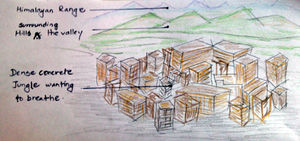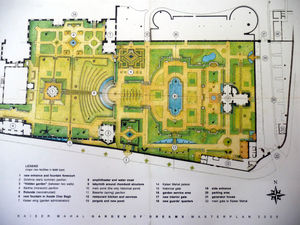Planting Design 2013 Working Group 14 - Case Study D
---> back to group page working group 14
Garden Of Dreams : A point of Departure
| Name | Garden Of Dreams | |
| Location | Kesharmahal, Kathmandu | |
| Country | Nepal | |
| Authors | Apekshya Dhungel | |

| ||
|
| ||
Rationale: Why is this case interesting?
Please give a short introduction to the site you have selected (not more than 150 words)
- A legacy, a history, created in the 20th century in Edwardian style as Kaiser Shamsher Rana’s private six seasons garden almost lost its identity in the lack of proper maintenance. In the 21st century, government took a bold decision to restore it with some foreign aid and now it stands with pride and beauty as a neo-classical historic garden with pavilions, amphitheatre, pond, pergola, varieties of flowers and fauna from around the world but maintaining its originality.
- Over population, lack of proper planning, haphazard growth to the existing planning, all are causing the city life to become a disgrace with lack of gardens and parks for refreshment.
- In such a situation, restoring the history and making it a social urban space and tourist place is today’s need in an overpopulated city like Kathmandu. What more could anyone ask for, a history in conservation and that too as a beautiful piece of green vegetation on a concrete jungle!
Author's perspective
A History in conservation, as a planner and city developer, it is very important to know the city's made from the past as well as its future should be contemplated. Every space should have a sense of place and that is only possible if it has a value, either from the past or designed in present context. I believe creating spaces is more important than designing and I intend to do so always.
Landscape and/or urban context of your case
- Kathmandu is a World heritage site with 130 important monuments and rich with history of the rulers of different centuries. There are seven UNESCO world heritage sites in the valley. Kathmandu valley is one of the most fertile cities in the world. But now it is proving out to be more fertile for buildings than vegetation. Population growth due to immigration is the main cause of uncontrolled city growth in terms of building construction and haphazard planning. As every city life has much to offer people are automatically attracted towards it. The problem is only encountered in the valley. If we drive or even walk few kilometers out of the valley, we find lots of green vegetation, farming and fresh air. So, landscaping is not a problem there. So, we need to think about the city and the people living here altogether.
Analytical drawings
Please add four analytical sketches/drawings (or montages/schemes) of your case and take the following aspects into account:
- natural dynamic versus cultural framework - in how far do these two forces come together in your case?
- dynamic through the year (you may imagine how the site looks in spring and summer, maybe you also remember it)
- highlight potentials and problems
- Analytical Drawings
Projective drawings
- Please add four projective sketches/drawings (or montages/schemes) for your case and take the following aspects into account:
- How would you like this case to change in the near future? (in 1-2 years)
- And how could it look like in 10-15 years?
- Projective Drawings
Summary and conclusion
The population of the valley has reached 2.5 million. The cultural heritage of the valley, is under direct threat and their environmental homogeneity is almost destroyed. The public utilities and spaces have nearly collapsed. The city is now rated one of the most polluted spots on the earth- with more than 115766 vehicles. Every inch of public space is facing encroachment and lack of green spaces is creating hazardous environment for the livings.
The impact of all this can be seen in the degradation of the social life of the people. So Garden Of Dreams is an approach or point of department for rising a hope for the city by providing small pockets of urban green spaces, roof gardens, vertical gardens so as to improve the lives of the people even if by small contribution as a start. We need to conserve what we have and renovate it according to today’s need. Our cultural heritage are of great value. But today, we need more innovative approaches to conserve them so as to add life to the city as well as prepare a healthy city life. So, planting design needs to be applied in wherever possible areas. And these areas are basically the heritage zones as there are the only spaces which have not received the burden of haphazard building constructions.
Like a drop in a Lake, from Garden of Dreams to City of Dreams - working towards building a healthy and beautiful life for people and the vegetation for a balanced eco-system.
Image Gallery
You may add a series of images/photos in addition to the sketches/drawings
- Image Gallery
References
* Please make sure that you give proper references of all external resources used.
* Do not use images of which you do not hold the copyright.
- Please add internet links to other resources if necessary.
Marland, Cheryl. (2007). Garden of Dreams-Layout. Retrieved from http://www.flickr.com/photos/lavenderstreak/3028797858/.
Malla, K. P. The Occupation of the Kathmandu Valley and its fallout. Retrieved from http://www.kpmalla.com/wp-content/uploads/2010/11/the-occupation-of-the-kathmandu..pdf.
http://gardenofdreams.org.np/history-of-garden-of-dreams/
http://en.wikipedia.org/wiki/Kathmandu
http://en.wikipedia.org/wiki/Pashupatinath_Temple
http://www.fotopedia.com/items/jmhullot-1561f436a5475db03408931cfdd597d3
About categories: You can add more categories with this tag: "", add your categories















